Distributed AI Applications: From Research Bench to Bedside
Building this critical distributed AI infrastructure alone, is insufficient. What is also needed is a path to bring AI research from bench to bedside. Today, far too many research projects are conducted in isolation by researchers whose ability to train neural networks is constrained by access to small local data sets, with results shared in the form of research papers.
Unfortunately, that’s generally where any new insights or learning ends — in a research paper, with no impact on patients. Seeing a similar problem in pharmaceuticals and medical devices, translational medicine emerged as a discipline to eliminate the barriers between the research bench and the bedside. While translational medicine has been applied to drugs and devices, there has been little work in translating software innovations.
One of the important uses of a distributed, in-the-building AI infrastructure service is to provide the platform to translate AI innovations from research to the bedside. We call the three-step, translational, AI process the Chang Method in honor of Dr. Anthony Chang, who inspired it.
Step 1: Take the AI algorithm developed on small data sets and implement it as a distributed AI application. This implementation would include using edge data services to access the usual data (e.g., MRI, Ultrasound, EEG, blood analysis), as well as a clinical user interface.
Step 2: Deploy the AI application to all the clinics and hospitals in BevelCloud’s distributed infrastructure. Now measure the accuracy.
Step 3: Improve accuracy. Now the AI application has access to a large diverse data set use federated learning to learn while preserving privacy.
We have taken a first step in identifying the numerous research applications (and some commercial ones) in our AI application commons. The AI application commons is for the clinical community to see what is going on and for the technology community to understand the breadth of applications.
BevelCloud was founded on a mission to reduce healthcare inequity, lower cost and improve outcomes for children locally, rurally and globally thru privacy-preserving, real-time AI applications. Building accurate AI applications in healthcare and life sciences requires large amounts of diverse training data. The data is in the buildings. Centralized architectures, which have powered ChatGPT, will not work in medicine. The data sizes are much larger, the demands for privacy much higher and the need for real-time results much greater. Instead BevelCloud has engineered a privacy-preserving, real-time distributed AI infrastructure to move the application to the data — inside the building.
